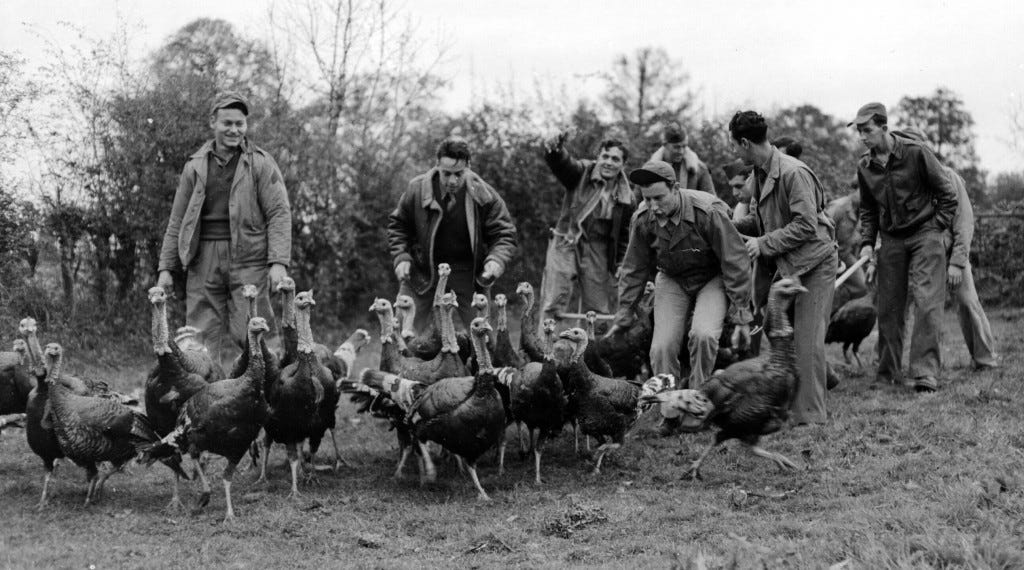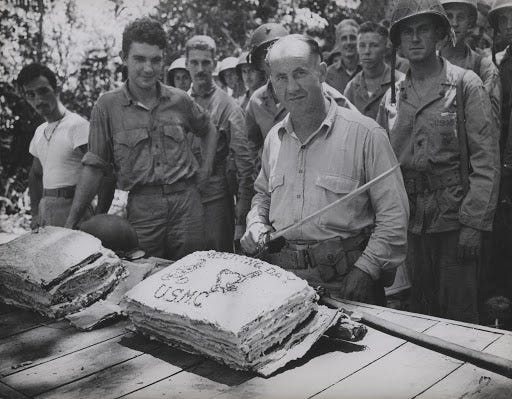Thanksgiving 1942: Exporting an American holiday
As members of a far-flung Commonwealth, the people of Britain and Australia had grown accustomed to the cultural differences among their brethren, so it was little surprise that their media took on an educational tone in explaining an unfamiliar tradition arriving upon their shores in November 1942.
"Thanksgiving Day, one of the festivals of the American year, will be celebrated in Sydney today," that city's Morning Herald informed its readership on Thursday, Nov. 26.
"The association of thanksgiving and turkeys is traditional, the feasting being symbolical of the thanks of the Pilgrim Fathers for their deliverance from early years of famine," the story continued. "Turkey will be served both at the American Centre in Elizabeth Street and at the new American Red Cross Centre, which will be opened this afternoon. ... Hundreds of turkeys have been specially fattened for the occasion. Another traditional dish will be 'succatash,' for which beans have been specially imported from the United States."
While that last sentence might have left the locals scratching their heads, an editorial elsewhere in the paper paid solemn tribute to the holiday and attempted to encapsulate what it meant for the men so far from home.
Last Thanksgiving Day the country was at peace, though the threat of war was pressing ever more darkly over the international scene. The two Japanese envoys were prosecuting their treacherous mission of conciliation in Washington, and ten days later, with the tragedy of Pearl Harbour confronting their outraged national pride, the American people found themselves at war.
What profound cause for thanksgiving it is that, after those dark days and all the anxieties of the months that followed, the first war-time Thanksgiving Day should see such a radical transformation of the world's battle scenes, wherever we may look.
The contrast between those peacetime celebrations in 1941 and the new reality of 1942 was particularly stark to the servicemen in foreign lands. Home-cooked meals were a distant memory to many by that point, and the beginning of the first full holiday season on wartime footing undoubtedly brought waves of homesickness that might not have hit quite so hard before that moment.
To their credit, the powers that be had anticipated this, and done everything they could to ensure as proper a Thanksgiving celebration as circumstances would allow.
In New Delhi, New York Times correspondent Herbert L. Matthews wrote of the effort put forth by Capt. John Kaufman, who "began his campaign a month ago to snag 120 turkeys, and it was not any too soon, because turkeys are rarities in this country."
Matthews continued: "The trimmings were there -- dressing and sweet potatoes, but no cranberries, for that is something India has never heard of. Innumerable pumpkin and mince pies were stacked up on tables along with a huge chocolate cake on which was written in sugar: 'Thanksgiving, 1942, India.' By 12 o'clock some hundreds of lads were 'straining at the leash' and shouting the old, familiar 'When do we eat?' and then the rush began."
Cranberry lovers were out of luck in North Africa, too. An Associated Press story filed from Cairo noted the fruit was "unobtainable" in that theater, so jams and applesauce were enlisted to serve as substitutes. In addition, sweet potato pie would pinch-hit for pumpkin.
An International News Service story out of London reported turkeys that had been shipped to Britain would be distributed to local hospitals "so that wounded and sick buddies of all allied services, together with civilians, will enjoy America's festival show bird." U.S. troops stationed in the U.K. would instead dine on roast pork or baked ham with a rum raisin sauce.
United Press correspondent James Roper described a party thrown by the Eighth Air Force for 200 children, ages 8 to 11, who had been orphaned in German bombing raids or were otherwise in need:
The youngsters' Thanksgiving dinner was the fare prepared for all American troops: vegetable soup, celery, pickles, sliced cheese, roast pork, gravy, apple sauce, yams, string beans, lettuce and tomato salad, fresh apples, bread and butter, jam, cocoa or coffee.
The pies were the product of Staff Sgt. James Yarnell, who had been up three consecutive nights, working harder than he ever did as a baker in Painesville, Ohio. They were made possible only after American troops had searched Britain for fresh pumpkins when they discovered that canned pumpkin was not available.
Community outreach like that occurred numerous places throughout Britain that day and would continue as the "American occupation" expanded over the coming years.
The centerpiece of the first wartime thanksgiving in Britain had quite a bit more pomp and circumstance, however, as more than 3,000 American soldiers, sailors, airmen and diplomats packed into Westminster Abbey for an 11:30 a.m. service. U.S. Army chaplain and Arkansas native Col. James L. Blakeney presided "in the homely fashion of an Ozark circuit rider, with a single American flag on the altar," wrote Cy Peterman of the Philadelphia Inquirer.
U.S. ambassador John G. Winant read President Roosevelt's Thanksgiving proclamation, and Cpl. Heinz Arnold of Long Island provided accompaniment on the organ throughout the service. In peacetime, he performed the same duties at Trinity Reformed Church in Queens.
Catholic and Jewish services also were held in London, at Westminster Cathedral and the West End Synagogue.
Buckingham Palace also hosted its first Thanksgiving celebration, with the King and Queen and daughters Elizabeth and Margaret welcoming Prime Minister Winston Churchill and numerous other guests.
Peterman wrapped up his Philadelphia Inquirer piece like this, grateful to have been a participant in a unique holiday celebration:
This dispatch closes as I rush to St. James School in Edmonton to tell the youngsters about Thanksgiving in the United States -- from Plymouth Rock and Massasoit to Franklin Field and Penn-Cornell -- but whatever the scores and how reverent the services back home, a Yank in Great Britain today will have cause to remember this Thanksgiving.
As first-time hosts, the Brits hoped they had acquitted themselves well, though they were quick to acknowledge there was no substitute for home.
"We may trust that the Americans in Britain had, within the limits of what we could offer them in these straitened times, a pleasant Thanksgiving Day," read an editorial in The Guardian. "The table was hardly bounteous (the turkey was especially elusive), and the family circle was broken. But so also it must have been in millions of homes in the United States where the work of war had still to go on."

The New York Times reinforced that notion on Page 8 of its Friday editions, noting it was "just another Thursday" for workers in shipyards and war plants around the metro area:
"Responding to the appeals of (War Production Board chairman) Donald M. Nelson and of Army and Navy officials, the great majority of war plants continued operation, with the workers delaying their Thanksgiving dinners until after the plant whistles had blown at the end of the day. In some plants a short luncheon period was granted to permit employees to enjoy their turkey."
At U.S. Steel's two shipbuilding yards in the New York area, employees were served celebratory meals prepared by chief cook Friedrich Wilhelm Kleinhaus and his crew, "who stuffed a hundred pounds of filling into more than 1,000 pounds of birds and concocted 12 gallons of cranberry sauce."
Plant managers were quick to reinforce the notion that the soldiers and sailors in the field were working that day, too, and without the luxury of going home at the end of their shift.
The absence of those loved ones was the overriding theme on the homefront.
In the house at 3716 Thompson Ave. in Kansas City, Missouri, Margaret Young put 10 place settings on the table for dinner, just as she had the previous year: One each for herself and her husband, Lester, and eight more for their children George, Frank, Merle, Edwin, Walter, Opal, Kenneth and Elsie.
Only half of the chairs were occupied, though. Her five oldest sons were scattered from California to Texas to Florida at various Army and Navy posts.
At the time, they couldn't have appreciated how fortunate they were. All five would eventually return home to celebrate Thanksgiving together once again.





